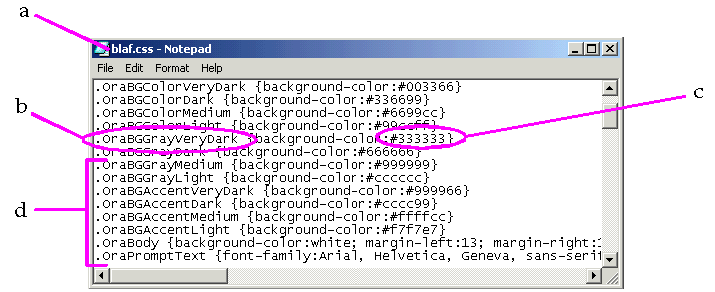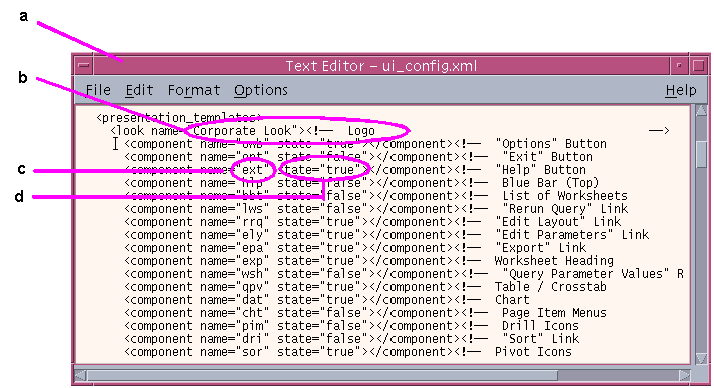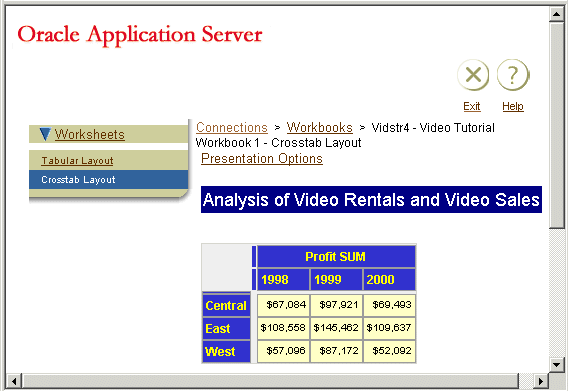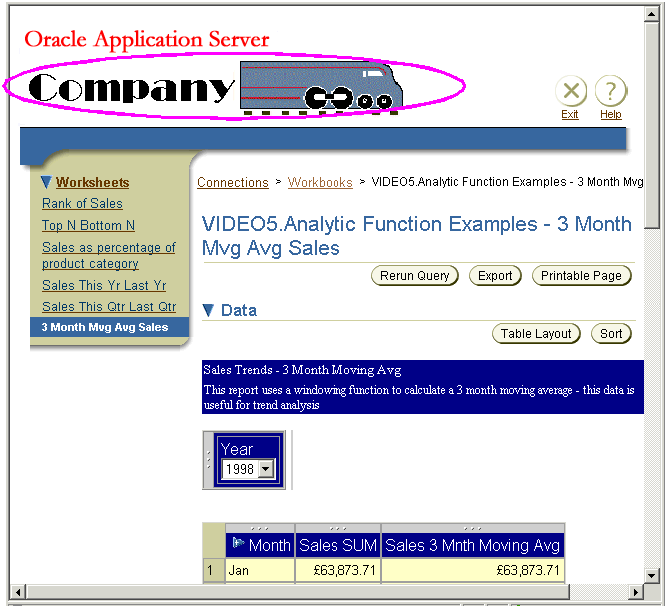7
Customizing OracleAS Discoverer Viewer
7.1 Customizing OracleAS Discoverer Viewer
This chapter explains how you can provide a customized Discoverer Viewer look and feel to end users. For example, you might want to replace Discoverer Viewer's Oracle logo with a different organization logo, or change the user interface background color.
Note: Discoverer Viewer users can also configure the user interface themselves on a per-session basis by setting their own presentation options (for more information, see "About presentation options").
This chapter contains the following topics:
- Section 7.2, "What is Discoverer Viewer customization?"
- Section 7.3, "Notes on customizing Discoverer in a multiple machine installation"
- Section 7.4, "What tools do you need to customize Discoverer Viewer?"
- Section 7.5, "About the sample browser look and feel file (blaf.htm)"
- Section 7.6, "About updating the Discoverer Viewer stylesheet file"
- Section 7.7, "About updating Discoverer Viewer XML files"
- Section 7.8, "About Discoverer Viewer options"
- Section 7.9, "About presentation options"
- Section 7.10, "About presentation templates"
- Section 7.11, "How to change the default Discoverer Viewer look and feel"
- Section 7.12, "How to change the default Discoverer Viewer logo"
- Section 7.13, "How to change Discoverer Viewer options"
- Section 7.14, "How to create a presentation template"
7.2 What is Discoverer Viewer customization?
You can customize Discoverer Viewer in the following ways:
- change Discoverer's font styles to match your organization's Internet look and feel (for more information, see Section 7.11, "How to change the default Discoverer Viewer look and feel")
- change Discoverer's default logo to a logo (i.e. graphic file) of your choice (for more information, see Section 7.12, "How to change the default Discoverer Viewer logo")
- specify Discoverer Viewer options (for more information, see Section 7.13, "How to change Discoverer Viewer options")
- provide presentation templates that specify which user interface components (e.g. header and footers, drill icons, row numbers) are displayed in Discoverer Viewer (for more information, see Section 7.9, "About presentation options" and Section 7.14, "How to create a presentation template")
You customize Discoverer Viewer by changing values stored in the following types of industry standard files that Discoverer uses to configure the user interface.
- Cascading Style Sheet (CSS)
- Extensible Markup Language (XML)
Notes
- If you do customize Discoverer Viewer, you are responsible for migrating customizations when you upgrade Discoverer.
- You can also provide a customized Discoverer Viewer look and feel by providing a bookmarked URL to end users. The URL contains presentation option settings that you set in the original Discoverer session.
- For more information about XML files, refer to the World Wide Web Consortium (W3C) Web site at http://www.w3.org/.
7.3 Notes on customizing Discoverer in a multiple machine installation
If you have deployed Discoverer in a multiple machine installation, note the following:
- If you want to deploy the same customized Discoverer Viewer user interface across all machines, you must repeat the customization changes on each Discoverer machine.
7.4 What tools do you need to customize Discoverer Viewer?
To customize Discoverer Viewer, you need to edit text files on the Discoverer middle tier using one of the following:
- a simple text editor
- a dedicated XML editor
Note: Dedicated XML editors are preferable because they make XML files easier to navigate and amend.
7.5 About the sample browser look and feel file (blaf.htm)
To help you customize Discoverer Viewer's look and feel, Discoverer is installed with a sample browser look and feel file (blaf.htm). For more information about the location of blaf.htm, see Section A.2, "List of Discoverer file locations".
The blaf.htm file displays the current look and feel settings for each display tag defined in the Discoverer Viewer cascading stylesheet (blaf.css). For more information about updating the blaf.css file, see Section 7.6, "About updating the Discoverer Viewer stylesheet file".
If you update the display tags in blaf.css, you can see changes reflected immediately in blaf.htm. You can use blaf.htm to find out which browser look and feel tags you need to change.
In the example below, the tag names in brackets or in the Tables section (e.g. OraHeader) are the display tags that you change in blaf.css.
Figure 7-1 Discoverer Viewer sample HTML file (blaf.htm)

Text description of the illustration testcard.gif
Notes
- Some of the styles in blaf.css affect the Discoverer Connections page that is also used by Discoverer Plus. For example, if you set the background-color:grey attribute for the OraTableCellText style, the fill color for table cells on the Connections page will be grey.
7.6 About updating the Discoverer Viewer stylesheet file
Discoverer Viewer uses a stylesheet file called blaf.css to format the Discoverer Viewer user interface. Blaf.css contains tags for each component of the Discoverer Viewer user interface that you can customize. The figure below shows an example of a blaf.css file.
Figure 7-2 An example of a blaf.css file displayed in a simple text editor

Text description of the illustration cust_7.gif
Key to figure:
- A blaf.css file opened in a text editor.
- A tag (OraBGGreyVeryDark) for one of the Discoverer Viewer background colors.
- The value of the tag (#333333), which is the RGB code for the color.
- Tags for other Discoverer Viewer styles.
To customize Discoverer Viewer, you change the value of the tags. For more information, see Section 7.11, "How to change the default Discoverer Viewer look and feel".
Notes
- For more information about RGB color codes, refer to any standard HTML reference manual.
- For more uniform results, use colors consistent across different browser types (i.e. safe colors) when customizing font styles.
- For more information about using the Discoverer Viewer cascading style sheet and its accompanying look and feel sample HTML file, see Section 7.5, "About the sample browser look and feel file (blaf.htm)".
7.7 About updating Discoverer Viewer XML files
The Discoverer Viewer XML files contain tags for each component of the Discoverer Viewer user interface that you can configure (for more information, see "About presentation options"). The figure below shows an example of a ui_config.xml file.
Figure 7-3 An example of a ui_config.xml file displayed in a simple text editor

Text description of the illustration cust_2.gif
Key to figure:
- A ui_config.xml file opened in an XML editor.
- A presentation template called Corporate Look (shipped with Discoverer).
- A tag called 'ext', which determines whether the Discoverer Viewer exit button is displayed.
- The value of the 'ext' tag (true), which means that the Discoverer Viewer exit button is displayed.
To update a tag, replace the 'state=' value with a new value. For example, to hide a user interface component, change its tag value from to 'true' to 'false'.
Note: The ui_config.xml file contains additional comments and tag labels to help you when making amendments. Comments are enclosed in the following tags: <!-- Comments -->.
7.8 About Discoverer Viewer options
Discoverer Viewer options are buttons on the Discoverer Viewer user interface that provide functionality to Discoverer Viewer users. For example, Presentation Options, Export. The screenshot below shows which Discoverer Viewer options you can display or remove when you customize Discoverer Viewer (i.e. Preferences, Rerun Query, Presentation Options, Export, and Printable Page).

Text description of the illustration disco_op.gif
For more information about customizing Discoverer Viewer by displaying or removing options, see Section 7.13, "How to change Discoverer Viewer options".
7.9 About presentation options
Presentation options define areas of the Discoverer Viewer user interface, such as headers, page areas, and footers. For example, in the worksheet area, you might not want to display worksheet headings or drill icons to Discoverer Viewer users.
Figure 7-4 Discoverer Viewer customization using presentation options

Text description of the illustration cust_10.gif
In the figure above, Discoverer Viewer has been customized on a per-session basis by removing the Discoverer logo, page footer, and export option.
You can store presentation options in presentation templates and make them available to Discoverer end users (for more information, see Section 7.10, "About presentation templates").
Note: You can also remove Discoverer UI components by editing the ui_config.xml file (for more information, see Section 7.13, "How to change Discoverer Viewer options").
7.10 About presentation templates
Presentation templates are sets of pre-defined presentation options that enable Discoverer Viewer users to customize the Discoverer Viewer user interface with a single click.
Note: Discoverer Viewer users can also set their own presentation options on a per-session basis using the Presentation Options page in Discoverer Viewer.
Figure 7-5 Discoverer Viewer Presentation Options page

Text description of the illustration cust_4.gif
Key to figure:
- Presentation options, which determine the Discoverer Viewer components that are displayed. For example, the List Of Worksheets is turned on, and the Page Header Logo is turned on.
- A Presentation template called Corporate Look, which applies pre-defined presentation options. To apply the Corporate Look presentation template to Discoverer Viewer, the user selects the Corporate Look link. The presentation options are then updated with the values stored in the ui_config.xml file.
Notes
7.11 How to change the default Discoverer Viewer look and feel
You change the default Discoverer Viewer look and feel when you want to provide a customized Discoverer Viewer look and feel to end users. For example, you might want to change the background UI color or UI fonts.
To change the default Discoverer Viewer look and feel:
- Open the Discoverer blaf.css file in a text editor or XML editor (for more information about the location of configuration files, see Section A.2, "List of Discoverer file locations").
You can update any of the tag values in the blaf.css file.
- Update the values in the blaf.css file as required.
For example, to change the paragraph style from black to blue, change the .OraBody{background-color:#000000} tag to .OraBody{background-color:#0000FF}
- Save the blaf.css file.
Hint: Display the blaf.htm file to preview changes that you make in the blaf.css file (for more information, see "About the sample browser look and feel file (blaf.htm)".
- Run Discoverer Viewer and open a workbook.
Hint: If you have an existing Discoverer Viewer session running, refresh the browser to update Discoverer Viewer with changes that you have made.
The look and feel changes that you made will be applied.
Notes
- You do not customize the actual worksheet text styles and cell colors of Discoverer Viewer using the blaf.css stylesheet. You define worksheet text styles and cell colors in Discoverer Plus.
If you want consistent worksheet text styles and cell colors (i.e. all worksheets have the same cell color and text color), make sure that Discoverer Plus users format worksheet cells in the same way. For more information, see Oracle Application Server Discoverer Plus User's Guide.
- In Japanese installations, blaf.css is called blafjp.css.
- To display or remove Discoverer Viewer buttons (e.g. Presentation Options or Preferences), see Section 7.13, "How to change Discoverer Viewer options"
7.12 How to change the default Discoverer Viewer logo
You change the default Discoverer Viewer logo when you want to replace it with a logo or graphic of your choice. For example, you might want to replace the default Discoverer Viewer logo with an organization logo.
Note: If you change the Discoverer Viewer logo, the new logo is also displayed on the Connect to Discoverer Viewer page and the Connect to Discoverer Plus page (for more information, see Section 3.5, "About the Discoverer connections pages").
The screenshot below shows the default Discoverer logo (highlighted) that you can change.

Text description of the illustration l1.gif
To change the default Discoverer Viewer logo:
- Open the ui_config.xml file in a text editor or XML editor (for more information about the location of configuration files, see Section A.2, "List of Discoverer file locations").
- Locate the logo tag in the configuration\appearance section of the ui_config.xml file.

Text description of the illustration logofile.gif
- Insert the URL of the graphic you want to use as a logo into the src attribute value field. For example, to replace the default Oracle logo with a logo stored in <ORACLE_HOME>/j2ee/OC4J_BI_Forms/applications/discoverer/web/common/xsl/my_logo.gif, the URL of the logo file can be either 'common/xsl/my_logo.gif' (i.e. using a relative path), or 'http://www.server.com:7779/discoverer/common/xsl/my_logo.gif' (i.e. an absolute path).
- Update the other tag attributes as required.
- Save the ui_config.xml file.
- Run Discoverer Viewer and open a workbook.
Note: If you have an existing Discoverer Viewer session running, refresh the browser to update Discoverer Viewer with changes that you have made.
The logo that you specified will appear in Discoverer Viewer.
The screenshot below shows an example of a Discoverer Viewer page where the default Discoverer logo has been replaced with an organization logo (highlighted).

Text description of the illustration l2.gif
Notes
- If you change the default Discoverer Viewer logo, you also change the logo that is displayed on the Discoverer connections page for Discoverer Plus.
7.13 How to change Discoverer Viewer options
You change Discoverer Viewer options when you want to deploy Discoverer Viewer with specific default options enforced for all end users. For example, if you do not want Discoverer Viewer users to set Presentation Options or Preferences, you remove the Presentation Options link and the Preferences link. For more information about Discoverer Viewer options, see Section 7.8, "About Discoverer Viewer options".
To change Discoverer Viewer Presentation Options:
- Open the ui_config.xml file in a text editor or XML editor (for more information about the location of configuration files, see Section A.2, "List of Discoverer file locations").
- Locate the configuration\appearance section of the ui_config.xml file.

Text description of the illustration logofila.gif
- Update the configuration\appearance tag attributes as required by setting Discoverer Viewer options to either 'true' or 'false'.
For example:
- Save the ui_config.xml file.
- Run Discoverer Viewer and open a worksheet in a workbook.
Notes
- If you are using OracleAS Web Cache to cache Discoverer Viewer pages, there are some Discoverer Viewer options that you must not display (for more information, see Section 6.6, "How to use Discoverer Viewer with OracleAS Web Cache").
- If you have an existing Discoverer Viewer session running, refresh the browser to update Discoverer Viewer with changes that you have made.
- Discoverer Viewer users can also remove Discoverer UI components on a per-session basis using presentation options (for more information, see Section 7.9, "About presentation options").
7.14 How to create a presentation template
You create a presentation template when you want to enable end users to configure the Discoverer Viewer user interface themselves using pre-defined presentation options. For more information about presentation options and presentation templates, see Section 7.9, "About presentation options" and Section 7.10, "About presentation templates".
The easiest way to create a presentation template is to cut and paste the Corporate Look template that is included in the ui_config.xml file, and edit the copy to suit your needs.
To create a presentation template:
- Open the ui_config.xml file in a text editor or XML editor (for more information about the location of configuration files, see Section A.2, "List of Discoverer file locations").
- Locate the Corporate Look presentation template in the configuration section of the ui_config.xml file.
- Select the Corporate Look presentation template.
- Cut and paste the Corporate Look presentation template into the ui_config.xml file, immediately after the original Corporate Look presentation template.
You should now have two presentation templates, both called Corporate Look.
Note: If you are using a simple text editor, copy all of the text between the tags <look name="Corporate Look"> and the first </look> tag that follows. For example:
<look name="Corporate Look">
<!-- Logo-->
<component name="log" state="false"/>
etc.
.
.
</look>
- In the second copied version of Corporate Look, change the name value to your preferred template name (note that the name you specify will be visible to users). For example, change <look name="Corporate Look"> to <look name="Money Portal look">.
- Change the various component values of the new presentation template to true or false as required. You can update all of the tags located beneath the new presentation template.
For example:
- to display the Discoverer Viewer logo, set the log value to true
- to remove the Rerun Query link, change the value of the display_rerun_query_link attribute to 'false'
Note: To help you identify tags in the ui_config.xml file, each tag has a comment label that tells you which part of the Discoverer Viewer user interface the tag relates to.
- Save the ui_config.xml file.
If you have an existing Discoverer Viewer session running, refresh the browser to update Discoverer Viewer with changes that you have made.
Discoverer Viewer is updated with the presentation options that you have selected. Existing Discoverer browser sessions need to be refreshed to see the new presentation template(s) that you created.
Notes
- Discoverer Viewer users can now select the new presentation template as follows:
- Run Discoverer Viewer and open a workbook.
- Click Presentation Options to display the Presentation Options page.
The available Presentation templates are displayed at the right hand side of the page below the Uncheck All option.
- Select the name of the presentation template to use.
For example, to apply a presentation option called Corporate Look, select the Corporate Look link.
- Click Apply to display the Discoverer Viewer worksheet with the presentation template applied.








